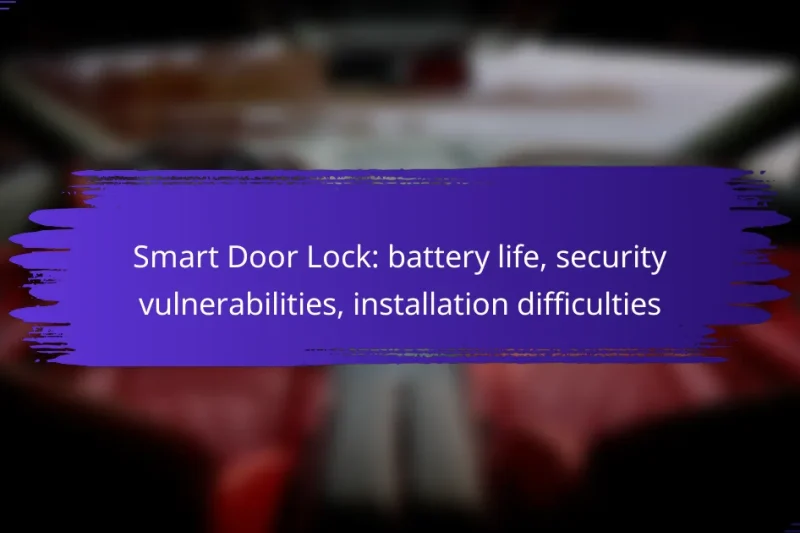Smart air purifiers offer an efficient solution for improving indoor air quality by effectively removing pollutants … Smart Air Purifier: filter replacement costs, noise levels, effectivenessRead more
Challenges with Smart Home Devices
Smart home devices have revolutionized the way we interact with our living spaces, but they come with a set of challenges that can impact their performance and user experience. Common issues include connectivity problems, compatibility with other devices, and security vulnerabilities, which can complicate their use. Understanding these challenges is essential for maximizing the benefits of smart home technology.
Smart Smoke Detector: false alarms, connectivity issues, maintenance challenges
Smart smoke detectors offer enhanced safety features, but they can also present challenges such as false … Smart Smoke Detector: false alarms, connectivity issues, maintenance challengesRead more
Smart Door Lock: battery life, security vulnerabilities, installation difficulties
Smart door locks offer convenience and enhanced security, but they come with considerations regarding battery life, … Smart Door Lock: battery life, security vulnerabilities, installation difficultiesRead more
What are the common challenges with smart home devices?
Smart home devices often face several challenges that can hinder their effectiveness and user satisfaction. Key issues include connectivity problems, compatibility with other devices, security vulnerabilities, complex user interfaces, and privacy concerns.
Connectivity issues
Connectivity issues can disrupt the performance of smart home devices, leading to frustration for users. These problems often arise from weak Wi-Fi signals, interference from other electronic devices, or network congestion.
To mitigate connectivity issues, ensure your router is centrally located and supports the latest Wi-Fi standards. Consider using Wi-Fi extenders or mesh networks to enhance coverage in larger homes.
Compatibility problems
Compatibility problems occur when smart home devices from different manufacturers do not work well together. This can limit the functionality of your smart home ecosystem and may require users to rely on multiple apps or hubs.
Before purchasing devices, check for compatibility with existing systems, such as Amazon Alexa, Google Assistant, or Apple HomeKit. Look for products that support common standards like Zigbee or Z-Wave to enhance interoperability.
Security vulnerabilities
Security vulnerabilities are a significant concern for smart home devices, as they can be targeted by hackers. Weak passwords, outdated firmware, and lack of encryption can expose devices to unauthorized access.
To improve security, regularly update device firmware and use strong, unique passwords. Consider enabling two-factor authentication where available and regularly review connected devices for any suspicious activity.
User interface complexity
User interface complexity can make it difficult for users to navigate and control their smart home devices effectively. Complicated setups or unintuitive apps can lead to user frustration and decreased usage.
When selecting smart home devices, prioritize those with user-friendly interfaces and clear instructions. Look for devices that offer voice control or mobile app integration to simplify operation.
Privacy concerns
Privacy concerns arise as smart home devices often collect personal data to function effectively. Users may worry about how their data is stored, shared, or used by manufacturers.
To protect your privacy, review the privacy policies of devices before purchasing. Opt for devices that allow you to control data sharing settings and consider using local storage options when available to minimize cloud exposure.
How can you troubleshoot connectivity issues in smart home devices?
Troubleshooting connectivity issues in smart home devices often involves checking the network environment and device settings. Start by assessing the Wi-Fi signal strength, restarting your router, and ensuring that your device firmware is up to date.
Check Wi-Fi signal strength
Wi-Fi signal strength is crucial for the performance of smart home devices. Use a smartphone or a laptop to test the signal strength in the area where your device is located. Ideally, the signal should be strong, typically above -70 dBm for reliable connectivity.
If the signal is weak, consider moving the router closer to the device or using Wi-Fi extenders to enhance coverage. Obstacles like walls and appliances can significantly reduce signal strength, so placement matters.
Restart the router
Restarting your router can resolve many connectivity issues. Simply unplug the router, wait for about 30 seconds, and then plug it back in. This process can refresh the network connection and clear temporary glitches.
After restarting, check if your smart home device reconnects. If problems persist, consider scheduling regular restarts weekly to maintain optimal performance.
Update firmware
Keeping your smart home devices updated is essential for security and functionality. Check the manufacturer’s website or the device app for any available firmware updates. Updates often fix bugs and improve connectivity.
To update, follow the instructions provided in the device manual or app. Regularly updating firmware can prevent connectivity issues and enhance the overall performance of your smart home system.
What are the best practices for ensuring compatibility among smart home devices?
To ensure compatibility among smart home devices, focus on choosing products from the same ecosystem, checking compatibility lists, and utilizing universal smart home hubs. These practices help streamline integration and enhance functionality across your devices.
Choose devices from the same ecosystem
Selecting devices from the same ecosystem, such as Apple HomeKit, Google Home, or Amazon Alexa, simplifies compatibility. These ecosystems are designed to work seamlessly together, allowing for easier setup and control through a single app.
For example, if you choose Philips Hue lights, a Nest thermostat, and a Ring doorbell, they can all be controlled through the Google Home app. This unified control reduces the chances of connectivity issues and enhances user experience.
Check compatibility lists
Before purchasing smart home devices, always check the manufacturer’s compatibility lists. Many brands provide detailed lists of products that work well together, helping you avoid devices that may not integrate properly.
For instance, if you are considering a new smart lock, verify that it is compatible with your existing smart home hub or ecosystem. This step can save you time and money by preventing the need for returns or exchanges.
Use universal smart home hubs
Universal smart home hubs can bridge the gap between different brands and ecosystems, allowing for greater flexibility. Devices like SmartThings or Hubitat can connect various products, even if they come from different manufacturers.
When using a universal hub, ensure it supports the protocols your devices use, such as Zigbee, Z-Wave, or Wi-Fi. This compatibility can significantly expand your options and create a more cohesive smart home environment.
How to enhance security for smart home devices?
Enhancing security for smart home devices involves implementing several key practices to protect your network and personal data. By changing default settings, enabling additional authentication methods, and keeping software updated, you can significantly reduce vulnerabilities.
Change default passwords
Changing default passwords is one of the simplest yet most effective ways to secure smart home devices. Many devices come with easily guessable factory passwords, making them prime targets for hackers. Use strong, unique passwords that combine letters, numbers, and symbols to enhance security.
Consider using a password manager to generate and store complex passwords. Regularly updating these passwords can further protect your devices from unauthorized access.
Enable two-factor authentication
Two-factor authentication (2FA) adds an extra layer of security by requiring a second form of verification in addition to your password. This could be a text message code, an email confirmation, or an authentication app prompt. Enabling 2FA can significantly reduce the risk of unauthorized access, even if your password is compromised.
Check if your smart home devices support 2FA and enable it wherever possible. This step is crucial for devices that control sensitive functions, such as security cameras or smart locks.
Regularly update software
Keeping the software of your smart home devices up to date is essential for maintaining security. Manufacturers frequently release updates to patch vulnerabilities and improve functionality. Regularly check for updates and install them promptly to protect against known threats.
Set your devices to automatically update if this option is available. This ensures that you are always running the latest software without needing to remember to do it manually.
What user interface features improve the experience with smart home devices?
User interface features that enhance the experience with smart home devices include customizable dashboards, voice control integration, and mobile app accessibility. These elements help users manage their devices more efficiently and intuitively, leading to a more seamless smart home experience.
Customizable dashboards
Customizable dashboards allow users to tailor their smart home interface according to their preferences and needs. Users can prioritize the most frequently used devices, arrange them for easy access, and even incorporate widgets that display relevant information, such as energy consumption or security alerts.
When setting up a dashboard, consider grouping devices by room or function to streamline control. Avoid cluttering the interface with unnecessary features, as simplicity often leads to better usability.
Voice control integration
Voice control integration enables users to operate smart home devices hands-free, enhancing convenience and accessibility. By using voice assistants like Amazon Alexa, Google Assistant, or Apple Siri, users can issue commands to control lighting, temperature, and security systems.
To maximize the effectiveness of voice control, ensure devices are compatible with your chosen assistant and that they are properly configured. Regularly update the software to benefit from improved recognition and new features.
Mobile app accessibility
Mobile app accessibility is crucial for managing smart home devices remotely. A well-designed app should provide a user-friendly interface, real-time notifications, and the ability to control devices from anywhere, making it easier to monitor home security or adjust settings on the go.
When selecting smart home devices, prioritize those with robust mobile applications that offer comprehensive features and regular updates. Be cautious of apps that require excessive permissions, as they may compromise your privacy and security.


